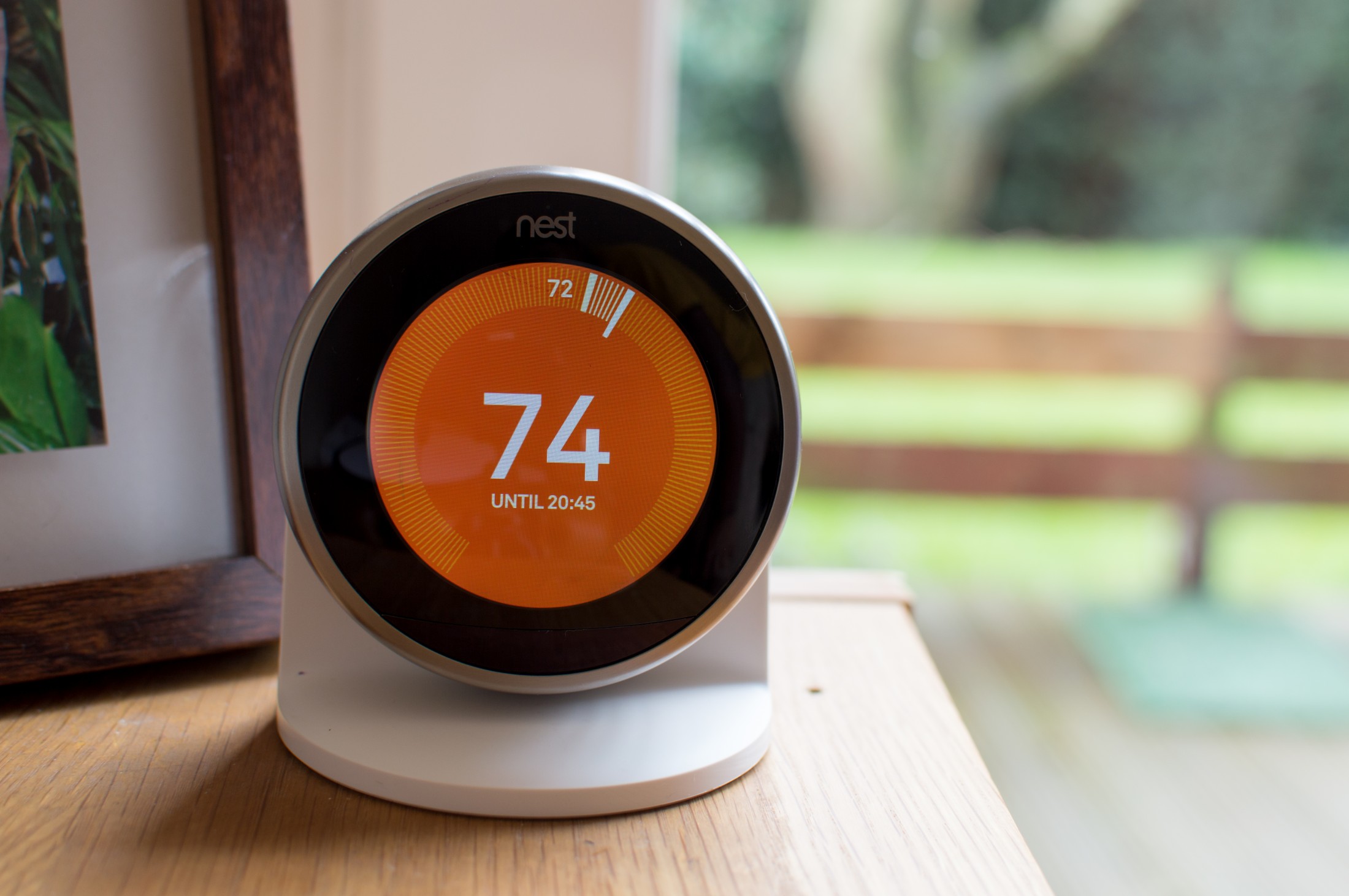
Controlling your home's interior temperature accounts for a significant portion of your household energy consumption, so it's understandable that the energy experts are fascinated with finding new ways to reduce energy usage in this area. Over the years, they've come up with guidelines that regulate usage during summer and winter such as setting your thermostat to 68 degrees Fahrenheit (20 degrees Celsius) in winter and 72 degrees Fahrenheit (22 degrees Celsius) in summer.
They suggested combining these guidelines with a programmable thermostat, which allows you to conserve energy without thinking about it. The problem is that most programmable thermostats aren't user-friendly, and well-meaning homeowners still miss out on the full benefits of this exciting technology.
For these people, Google has great news. The tech giant's Nest Learning Thermostat makes saving on energy bills convenient, easy, and even fun. The Nest thermostat is in its 10th year of production, so you're probably familiar with Google's Nest products.
The Nest thermostat is a smart thermostat, which means that it contains machine learning algorithms that help the device to automatically optimize temperatures in your home based on your household's preferences. While the idea that your thermostat can learn your preferences and work without complicated programming is appealing, you'll probably want to know how this gadget performs these feats and if Google has perfected it enough to work with your specific HVAC system.
Here are some details about the latest Nest Learning Thermostat's operations and how you can find out if the device is compatible with your heating and cooling unit.
How Nest Learns and Optimizes Temperatures
In addition to the standard sensors that programmable thermostats have, the Nest Learning Thermostat has sensors and memory that are as sophisticated as full-sized computing devices. The thermostat sends and receives digital signals that detect the type of HVAC system that you have and how it's wired. If your system is compatible with the Nest thermostat, it will start to learn about your heating and cooling after a seven-day setup period.
Here's what you can expect during the first week of activation.
Day One
You set the initial temperature. If the setting is changed during the day, the Nest thermostat makes note of it.
Day Two
The Nest thermostat stores your household's temperature preferences based on the first day's choices. The device is equipped with geolocation technology that detects the presence of household members via their phones. The developers of the Nest Learning Thermostat designed the device to help homeowners to save energy. When the device detects that household members have gone for the day, it dials down the heating or cooling in the home.
Days Three Through Five
During the middle of the first week of operation, your Nest Thermostat will continue recording changes that you make to your thermostat settings. It will not only note the temperatures that you prefer in your home, but it will also store data about the day and the exact time that you make those changes. The Nest thermostat will make changes to the scheduled temperatures based on what it learns. It gives you updates about your home's temperature via its mobile app.
Days Six and Seven
During the last two days of the setup process, the Nest Learning Thermostat stops recording every little change that you make to its settings. Instead, it only records actions that show significant patterns such as changing the thermostat setting to 70 degrees Fahrenheit (21 degrees Celsius) at 5 p.m. for two consecutive days.
Even after the initial setup is complete, the thermostat continues to learn about your household's energy usage based on patterns that it records. When you make changes that it considers to be energy-efficient, the thermostat shows a green leaf on its display. Use these cues to optimize your energy consumption while saving money on your monthly energy bills.
Compatible HVAC Systems
Today's HVAC systems come in a variety of styles and configurations, and the designers of the Nest thermostat made sure that their product was compatible with the most popular systems that are on the market. After installing your Nest thermostat, the device can detect a compatible system during initial setup.
These HVAC systems are compatible with the Nest thermostat.
- Single-stage heating and cooling units
- Single-stage heating with dual-stage cooling
- Dual-stage heating with single-stage cooling
- Single-stage heat pump with auxiliary heat
- Single-stage heat pump with dual-stage furnace heating
- Dual-stage heat pump with auxiliary heat - Dual-stage heat pump with dual-stage furnace heating
- Whole-home dehumidifier
- Whole-home humidifier
- Dual-stage cooling and dual-stage furnace heating
The Nest Learning Thermostat works with electric, natural gas, and oil heating and cooling units. If your system is a 24V system, it will more than likely be compatible with the Nest Learning Thermostat.
Some HVAC systems are compatible with the latest Nest thermostat, but they require special configuration. The listed dual-stage heating and cooling systems and the whole-home humidifiers and dehumidifiers are just some examples.
Ductless systems also fall into this category. These units require an adapter to integrate with the Nest Learning Thermostat.
To set up a Nest Learning Thermostat with a ductless system, you'll need to power off your system and install the adapter. Connect the wiring between the Nest thermostat and the adapter. Turn on the power and complete the setup of your Nest thermostat.
While some HVAC units have straightforward configuration setups, others are more complex. Google recommends getting professional installation help in those cases.
You may be wondering if there are HVAC systems that aren't compatible with the latest Nest thermostat even with adapters and special wiring. There are a few types of HVAC units that don't work with Nest thermostats. Most of these incompatibilities have to do with the thermostat's voltage requirements.
For example, millivolt heaters use natural gas or electricity to deliver warmth to rooms while conserving energy. These low-voltage units are installed on walls or as floor models. They can't generate enough power to run the Nest Learning Thermostat. Some HVAC systems run on solid fuels such as coal or wood chips. These systems don't work with the Nest Learning Thermostat either.
Testing for Compatibility
There's nothing worse than getting your hopes up about a wonderful product, buying it, and finding out that you can't use it. Google anticipated this and dedicated a web page to compatibility discovery for its Nest thermostat products.
The online compatibility checker guides you through a series of questions about your thermostat to find out if your HVAC unit will work with Nest. The questionnaire will ask you to power off your unit and remove your thermostat's cover. If your thermostat has stranded wires or is labeled 110V or 120V, your HVAC system won't work with the Nest Learning Thermostat without some professional rewiring.
Your thermostat doesn't display any of those items, and you're ready to move on to the next question. The guide asks you to look at the wiring labels on your thermostat. It displays a group of wire labels and asks you to select the ones that represent the connected wires in your unit. If your connected wires perfectly match the ones that work best with the Nest thermostat, the tool will let you know.
If there is a discrepancy, the tool will ask you to take a picture of your thermostat's wiring. You'll be prompted to upload it so that tech support can take a closer look at your system. There are HVAC units that have connected wires that aren't supported by the Nest thermostat. When you select those wire labels on the display, the tool will let you know that your system isn't compatible with Nest thermostats.
Conclusion
The benefits of the Nest Learning Thermostat rival those of the leading programmable thermostats on the market. Besides being able to optimize your home's interior temperature based on your personal preferences and remote-sensor data about outdoor temperatures, you can control the device from anywhere in the world via a convenient mobile app. Updates to the Nest Learning Thermostat ensure that it works with most types of HVAC systems.
Find out if it works with your heating and cooling unit by clicking on the compatibility checker today.
